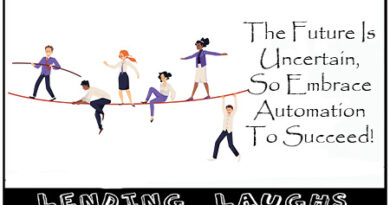Is Your Current Mortgage Technology Outdated And Costing You Money?
Our industry has been and still is full of ancient, antiquated technology. So when I got into the industry, I started building tech. And what’s funny is in 24 years, guess what? It’s the same technology lenders are using. Why is this important? As lenders look to respond to current market conditions cutting costs and creating excellent efficiency is critical.
A knee-jerk reaction is to stick with the same old technology they’ve been using year in and year out. Why is that potentially a significant mistake?
First, let’s talk about the fundamentals of technology and what iteration of the evolution of technology we’re in. Are we in the first, second, third, or fourth generation of our technology? It’s somewhere like the third generation of technology: transistor radios, simple capacitors, and analog computers. Now it’s where we are today.
It was like electricity. You travel around the world. Other countries have different plugs. There was no uniformity. It was a brand-new technology. It’s electricity; it’s new.
And then, over time, standards started to emerge. If everyone does 110 volts, and you make machines that can handle 110 volts, the stuff won’t break. The lines will work. And if everyone makes the plug look like this, we got universality. Everyone’s going to be able to plug their thing in. And oh, overseas, they come up with their own idea? Great, we have an adapter. Real simple, plug it in here, go overseas, you can plug it right in the wall, it down converts, up converts, does what it’s supposed to do. But it took decades and decades of electricity being out there before people started to go to this standardization. Technology’s done the same thing. If you think about it, mortgages in the nineties, one when people started using computers and stuff to do mortgages.
I remember getting appraisals with people taking pictures, taping them to pieces of paper, and typing them up on the typewriter. And I still remember that to this… Still remember getting those. And that technology was there because it was new. So there needed to be more standardization. The thought of the Cloud and software as a service and platform didn’t even exist in the nineties. Those weren’t thoughts. The first thought of Cloud computing in the early two thousand was LoudCloud. So all these things didn’t exist. So these systems were built. Pioneers, right? Great. But you want to use something other than Thomas Edison’s first electric machine, whatever he built. You want to use the one he built at the end of his career. Or you want to use the one people have built today who has built upon technology.
And that’s where we are now. Is this mortgage technology old? And now there’s standardization. So there are companies like Insellerate, and there are other companies. There’s a group of companies that we work with, Lender Price being one of them, BeSmartee being one of them, and Loadstar being another, that we use more modern technology. And we build differently. We use microservices, and we’re what’s called API-driven.
So our software isn’t one giant blob of code; it’s a bunch of individual pieces of software that work together. So why is that important? If you want to integrate something, change something, or innovate something, I can easily do it because our system is built; it’s like a Lego set made with all the connectors, and you can click things in. You don’t have to build anything custom if you will. And that’s the difference.
People are trying to cut costs, and they say, “Well, I don’t know if I should invest in technology. I’ll keep using what I have.” How much is that costing them in dollars? Meaning they have outdated technology, it’s harder to support; it doesn’t connect to all the different things in their tech stack. They can only be as competitive if they can make changes.
Some lenders see cutting technology costs as a cost-saving effort because, truthfully, much of their technology is not making them money. So they’re like, “Well, this CRM system, no one’s using, we’re not getting that much of anything out of it.” So, that is a cost saving. It’s not doing anything for you because it needs to be integrated, and if it needs to be set up right and has all those deep connections within your tech stack to manage customer service, drive conversions… Now, more than ever, if someone’s going to get a loan and you talk to them, you better ensure you get that loan. Because every lead matters, now more than ever.
We have conducted our annual MBA contact study for the last four years. We go online; we apply to mortgage companies, ask them for a mortgage, and then time how often they call, text, email, and all that stuff. I’m not shocked because I’ve been doing it for so long. Still, every year it’s like half the companies don’t even respond to a lead a single time, an inquiry, not even one response. And 10% of people call. Only 2% or 11% of people use text messages. It’s astounding. So it costs people lots of money because there are people out there, you have customers asking for mortgages, and you don’t realize it. Still, your staff needs to communicate with them.
I think the first knee-jerk reaction is, “Well then, you’re saying my staff is lazy.” And that’s not what we’re saying. We’re saying that the systems aren’t communicating with one another because there’s no alert or notification. After all, that information is not easily accessible on a mobile device; often, the loan officer’s not getting the news; they’re getting it days or weeks later. It gets tied up in a bunch of other emails. The systems they’re using are not working because they need to be in sync, and it’s not one collaborative tool they can use to accomplish those tasks.
The systems are not driving business to the loan officers or action. It’s not about being lazy. I look at myself as a non-lazy person. I was a loan officer and still do some selling at Insellerate. We have a sales team, but I still get involved and have to follow up with people. I use Insellerate to manage myself because it’s about something other than laziness; no one can remember everyone you talk to. And if you’re a loan officer, that could be, depending on what kind of loan, hundreds of people could every month. How in the world are you ever going to remember that? Oh shoot, you know what? I forgot that Jim and Sally said they’re moving at the end of the year because their daughter’s going to college. Once their daughter goes to college, they’ll move to Florida.
You don’t remember that. But if the systems are set up, you don’t have to remember that. And I think that the key is to automate; instead of trying to tell loan officers, “Use the software, use the software, use the software, use the software,” automate it. So even if they don’t use the software, it does the job.
Well, one of the other areas that we talk about is cost savings, and it’s incredible as you spoke about modern CRMs and everything; there are several lenders out there because they have multiple lending channels, and they’ve purchased different CRMs. I have one for Consumer Direct, but that doesn’t work with retail. So I bought a different one for retail, and I bought one for wholesale.
One of the things that we’ve been talking about a lot with lenders is your total cost of ownership of whatever technology you have right now. You have to understand what that is. It’s not just the monthly fee. If you’re a Salesforce customer, it’s not just your monthly Salesforce bill. It’s your monthly Salesforce bill plus the customization and the consultants you have to hire to come in and do the work, plus the full-time staff member or team you have to run sales for. So you must start adding all these total costs and all these different systems. And you’re right; if I’m a lender and I have three systems, it’s going to be hard to get someone to be an expert in managing all three systems and be efficient and get all they can get out of those three systems.
So when you use software like Insellerate, what we focused on is, let’s make it easy. I was a lender. And lenders are usually thinly managed. We don’t have these big groups and huge… Not everyone is like Quicken, which has a hundred programmers on staff. How about we make it so that we can make it easy for them to manage and easy for them to use? And that’s what we focused on, how to make that simple and easy, so that way, now the technology is doing what you want it to do. It’s driving money, its driving results, and it’s set up for you.

Josh Friend began his career as a loan officer and soon moved on to open six mortgage call centers. Over the past 21 years, he has grown to manage and train thousands of loan officers, processors, and marketing managers. That experience has helped him market to millions of consumers, with that experience he has dedicated himself to building software for the mortgage industry since 2004. With a keen eye for developing best-in-class sales processes, he leveraged automation & engagement software to build a better loan cycle. Combining the best from both a CRM and lead management system, Josh now enables lenders to achieve higher revenue goals with Insellerate’s award-winning CRM & Engagement Platform.



